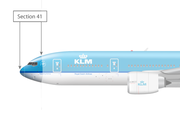
Boeing fuselage Section 41
Encyclopedia

Boeing Commercial Airplanes
Boeing Commercial Airplanes designs, assembles, markets and sells large commercial jet aircraft and provides product-related maintenance and training to customers worldwide...
aircraft, from the nose to aft of the cockpit. In some models it includes the forward door and may extend to the first class cabin. Along with the wings, it is one of the most complex parts of an aircraft, and includes the largest share (around 40%) of an aircraft's avionics and control systems. Other portions of the aircraft are numbered as well, but those numbers often vary, and Section 41 plays a particularly important role.
As Section 41 is a complex component, identical models are shared within two groups of Boeing aircraft:
- The 707/720Boeing 707The Boeing 707 is a four-engine narrow-body commercial passenger jet airliner developed by Boeing in the early 1950s. Its name is most commonly pronounced as "Seven Oh Seven". The first airline to operate the 707 was Pan American World Airways, inaugurating the type's first commercial flight on...
, 727Boeing 727The Boeing 727 is a mid-size, narrow-body, three-engine, T-tailed commercial jet airliner, manufactured by Boeing. The Boeing 727 first flew in 1963, and for over a decade more were built per year than any other jet airliner. When production ended in 1984 a total of 1,832 aircraft had been produced...
, and 737Boeing 737The Boeing 737 is a short- to medium-range, twin-engine narrow-body jet airliner. Originally developed as a shorter, lower-cost twin-engine airliner derived from Boeing's 707 and 727, the 737 has developed into a family of nine passenger models with a capacity of 85 to 215 passengers...
have a common Section 41. Newer versions of the 737 have a different avionics package while retaining structural commonality. - The 767Boeing 767The Boeing 767 is a mid-size, wide-body twin-engine jet airliner built by Boeing Commercial Airplanes. It was the manufacturer's first wide-body twinjet and its first airliner with a two-crew glass cockpit. The aircraft features two turbofan engines, a supercritical wing, and a conventional tail...
and 777Boeing 777The Boeing 777 is a long-range, wide-body twin-engine jet airliner manufactured by Boeing Commercial Airplanes. It is the world's largest twinjet and is commonly referred to as the "Triple Seven". The aircraft has seating for over 300 passengers and has a range from , depending on model...
also share the frontal portion. These aircraft have vastly different avionics, however. - The forward-most section of the 787 encompasses more of the aircraft than in past models. This is due to the aircraft's modular design and Carbon fiber reinforced plastic (CFRP) composite construction (the first airliner with majority of airframe made of composites).
The identity of this portion of Boeing aircraft came to higher prominence during the investigation of the Pan Am Flight 103
Pan Am Flight 103
Pan Am Flight 103 was Pan American World Airways' third daily scheduled transatlantic flight from London Heathrow Airport to New York's John F. Kennedy International Airport...
incident in 1988. Section 41s for all Boeing 7xx-series airliners, with the exception of the 717
Boeing 717
The Boeing 717 is a twin-engine, single-aisle jet airliner, developed for the 100-seat market. The airliner was designed and marketed by McDonnell Douglas as the MD-95, a third-generation derivative of the DC-9. Capable of seating of up to 117 passengers, the 717 has maximum range of...
, are constructed at what was formerly Boeing's Wichita, Kansas
Wichita, Kansas
Wichita is the largest city in the U.S. state of Kansas.As of the 2010 census, the city population was 382,368. Located in south-central Kansas on the Arkansas River, Wichita is the county seat of Sedgwick County and the principal city of the Wichita metropolitan area...
facility (now Spirit AeroSystems
Spirit AeroSystems
Spirit AeroSystems, Inc. , based in Wichita, Kansas, is the world's largest first-tier aerostructures manufacturer. The company builds several important pieces of Boeing aircraft, including the fuselage of the 737, portions of the 787 fuselage, and the cockpit of nearly all of its airliners...
).
The phenomenon of sharing cockpit sections across models is not exclusive to Boeing. Indeed, the de Havilland Comet
De Havilland Comet
The de Havilland DH 106 Comet was the world's first commercial jet airliner to reach production. Developed and manufactured by de Havilland at the Hatfield, Hertfordshire, United Kingdom headquarters, it first flew in 1949 and was a landmark in aeronautical design...
and Sud Aviation SE 210 Caravelle
Sud Aviation Caravelle
The Sud Aviation SE 210 Caravelle was the first short/medium-range jet airliner produced by the French Sud Aviation firm starting in 1955 . The Caravelle was one of the more successful European first generation jetliners, selling throughout Europe and even penetrating the United States market, with...
shared their frontal section in much the same manner. This is also true for the Tupolev Tu-204/-214
Tupolev Tu-204
The Tupolev Tu-204 is a twin-engined medium-range jet airliner capable of carrying 210 passengers, designed by Tupolev and produced by Aviastar SP and Kazan Aircraft Production Association. First introduced in 1989, it is considered to be broadly equivalent to the Boeing 757 and has competitive...
and Tu-334
Tupolev Tu-334
-See also:-References:* Gordon, Yefim; Rigamant, Vladimir . OKB Tupolev: A History of the Design Bureau and its Aircraft. Hinckley, England: Midland Publishing. ISBN 1-85780-214-4....
.

